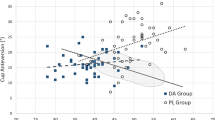Abstract
Background
Cup malalignment increase impingement, dislocation, cup migration, and polyethylene wear. Screw fixation for enhanced stability is the preferred option in cases of doubtful primary cup stability. There have been few studies about alignment changes after screw fixation, which may be another cause of cup malalignment. This study aimed to evaluate cup alignment change after screw fixation.
Materials and Methods
Patients undergoing imageless navigation total hip arthroplasty using screws fixation for acetabular cup were corrected. After the press-fit cup was fully seated, the cup orientation was recorded. After screws were inserted, the cup orientation was recorded again to calculate the alignment change.
Results
There were 99 cases with a mean age 63.7 years (25–93). Alignment change after screw fixation was found in 73 cases (73.7%). There were 56 cases (56.6%) with inclination angle change and the mean change was 2.21° (0°–8°). The inclination angle increased in 47 cases (47.5%) with 9 cases (9.1%) increased by 5° or more and decreased in 9 cases (9.1%). There was statistically significant difference between patients using one screw and patients using two or more screws in inclination angle change, 1.56° (0°–5°) and 3.4° (0°–8°), respectively (P = 0.0039). There was statistically significant correlation between inclination angle change and number of screws (r = 0.5401, P < 0.01). There were 49 cases (49.5%) with anteversion angle change and the mean change was 1.67° (0°–5°). The anteversion angle increased in 31 cases (31.3%), decreased in 18 cases (18.2%) with two cases (2%) decreased by 5° or more. There was significant difference between patients using one screw and patients using two or more screws in anteversion angle change, 1.46° (0°– 5°) and 2.21° (0°–5°), respectively (P = 0.009). There was significant correlation between anteversion angle change and number of screws (r = 0.284, P = 0.048).
Conclusions
Changes in cup alignment after screw fixation were detected in most cases. It is one possible cause of cup malalignment.
Similar content being viewed by others
References
Kennedy JG, Rogers WB, Soffe KE, Sullivan RJ, Griffen DG, Sheehan LJ. Effect of acetabular component orientation on recurrent dislocation, pelvic osteolysis, polyethylene wear, and component migration. J Arthroplasty 1998;13:530–4.
Maratt JD, Esposito CI, McLawhorn AS, Jerabek SA, Padgett DE, Mayman DJ, et al. Pelvic tilt in patients undergoing total hip arthroplasty: When does it matter? J Arthroplasty 2015;30:387–91.
Nishikubo Y, Fujioka M, Ueshima K, Saito M, Kubo T. Preoperative fluoroscopic imaging reduces variability of acetabular component positioning. J Arthroplasty 2011;26:1088–94.
Grammatopoulos G, Pandit HG, da Assunção R, Taylor A, McLardy-Smith P, De Smet KA, et al. Pelvic position and movement during hip replacement. Bone Joint J 2014;96-B: 876–83.
Nishii T, Sakai T, Takao M, Sugano N. Fluctuation of cup orientation during press-fit insertion: A possible cause of malpositioning. J Arthroplasty 2015;30:1847–51.
Suksathien Y, Suksathien R, Chaiwirattana P. Accuracy of acetabular cup placement in navigated THA with modified registration technique in semilateral decubitus position. J Med Assoc Thai 2014;97:1089–95.
Lewinnek GE, Lewis JL, Tarr R, Compere CL, Zimmerman JR. Dislocations after total hip-replacement arthroplasties. J Bone Joint Surg Am 1978;60:217–20.
Fehring KA, Owen JR, Kurdin AA, Wayne JS, Jiranek WA. Initial stability of press-fit acetabular components under rotational forces. J Arthroplasty 2014;29:1038–42.
Milne LP, Kop AM, Kuster MS. Polyaxial locking and compression screws improve construct stiffness of acetabular cup fixation: A biomechanical study. J Arthroplasty 2014;29:1043–51.
Fujishiro T, Hayashi S, Kanzaki N, Hashimoto S, Shibanuma N, Kurosaka M. Effect of screw fixation on acetabular component alignment change in total hip arthroplasty. Int Orthop 2014;38:1155–8.
Author information
Authors and Affiliations
Corresponding author
Rights and permissions
About this article
Cite this article
Suksathien, Y., Piyapromdee, U. & Tippimanchai, T. Cup Alignment Change after Screw Fixation in Total Hip Arthroplasty. IJOO 53, 618–621 (2019). https://doi.org/10.4103/ortho.IJOrtho_451_18
Published:
Issue Date:
DOI: https://doi.org/10.4103/ortho.IJOrtho_451_18




